Family : Felidae

Text © DrSc Giuliano Russini – Biologist Zoologist

English translation by Mario Beltramini
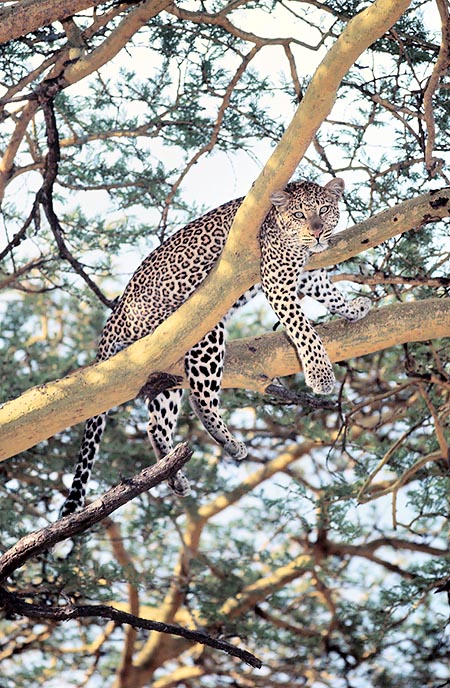
A Panthera pardus disguised between the branches © Giuseppe Mazza
The Panthera pardus, eutherian mammal, carnivore, quadruped, placentate, belongs to the family of the Felidae, subfamily of the Pantherinae.
In Africa it is called leopard, in Asia they prefer to talk of maculated panther for the wild-type and of black panther for the melanistic form, which is very diffused in that area.
It is the third-largest feline after the Lion (Panthera leo) and the Tiger (Panthera tigris), along with the Jaguar (Panthera onca) and the Puma (Puma concolor).
Nowadays, it is endemic to sub-Saharan Africa and Asia. The biggest density of population for the melanistic form is registered in Java and Sunda Islands.
After some biologists, the melanistic specimens form a true and proper race. For others, on the contrary, as it happens for the jaguar, it is to be thought to mutants, subjected to an over-expression of melanin, due to the mutation of a recessive gene.
They live also in the tropical forests of South Africa, close to Cape Town, so much that some authors have classified them as two subspecies: Javan Leopard ( Panthera pardus melas ) and Cape Leopard ( Panthera pardus melanotica ). But, to complicate the things, they have found melanistic endemic specimens (not grown wild again or feral, that is, not escaped from zoological gardens, zoo-parks or zoo-safaris), also in Manchuria and in Siberia.
A detailed zoogeographic analysis, based on significant skeletal findings and the contemporaneous presence of a certain number of specimens, has shown that the home range of this feline is extremely complex, as it is, anyway, also its eco-ethology.
In the past, but even now in some of these regions, the Panthera pardus lived in Turkey, Asia Minor, North Africa (Egypt, Algeria, Morocco, Tunisia), Sahara, South Africa, East Africa, West Africa, the whole Asia and nearby islands, till the Far East (North and South Korea, China, Mongolia, Siberia), and even in Japan and in the Philippine archipelago, not to forget Western Europe, in Spain, Italy and South France. Here probably they got extinct due to the intense hunting made by the old Romans, the Iberians and the Gauls for its highly valued fur. They were circulating also in East Europe, the Balkans and the immense Russian territory. This almost cosmopolitan distribution shows the enormous capacity of adaptation for the eco-physiology, the alimentary ecology and the eco-ethology in this splendid animal, still now capable to live and reproduce in different biotopes, extreme at times.
Before seeing in how many subspecies is subdivided or is capable to be subdivided the Panthera pardus, we wish to briefly mention the fact that its old ancestor, from which also the jaguar should have descended, is identifiable for some biologists in the Clouded Leopard (Neofelis nebulosa), endemic to the pluvial forests of south-eastern Asia. An extremely rare feline, in great danger of extinction, which in the wild counts few hundreds of specimens. Some are present in zoological gardens, where they have also reproduced. Smaller than jaguar and leopard, the Neofelis nebulosa usually weighs 15-23 kg, with 25-40 cm at the withers.
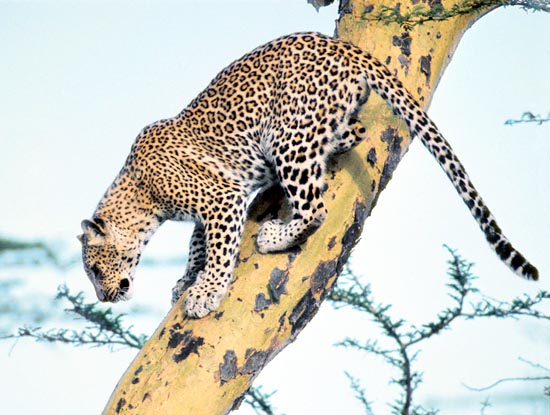
The long tail allows the leopard to keep a perfect balance © Giuseppe Mazza
A mantle with big elliptical, irregular, dots, dark-edged, creating cloud-shaped spots, and, above all, monstrous canines. They are 6-7 cm long, like those of the Tiger (Panthera tigris), which, confronted to the size of the species, has without any doubt the biggest teeth in the world of the felines. For other authors, the Neofelis nebulosa I,s on the contrary, a subspecies of the Panthera pardus. After them, the ancestral progenitor of the leopard and the jaguar should be in fact the Barbary leopard, which other biologist zoologists consider instead as a subspecies, and they classify it Panthera pardus panthera, with the typical trinomial denomination of the subspecies.
In origin, before the last desertification of the Sahara, the Barbary leopard was spread all over North Africa. Nowadays, maybe, it survives sporadically in North-Western Africa, up to the Moroccan Atlas Mountains. The last sightings by the biologists and the last killings by poachers, who unluckily were looking for their fur, date back to 1991, close to the valley of the Jbel Bou Iblane mount in the Moroccan Atlas. The IUCN thinks that it might be extinct, or that, at the most a ten of specimens, or little more, are extant, at altitudes reaching the 3100 metres above the sea level, in areas where, theoretically, they might live thanks to their physiology. But these observations and censuses are particular complicate, in many cases even impossible. The last captive specimen seems to have passed away in an American zoological garden in 1999.
Whatever, this elusive precursor of the panther and the Panthera pardus, has not yet been identified with certainty, even if to consider its existence is much more than a simple hypothesis. A first subdivision considers nine subspecies: Panthera pardus pardus (Barbary leopard); Panthera pardus saxicolor (Iranian and Persian leopard, South-western Asia); Panthera pardus orientalis (Amur leopard, Russian Far East, northern China, Korea); Panthera pardus japonensis (Northern China leopard); Panthera pardus fusca (Indian leopard, south-eastern Pakistan, Nepal); Panthera pardus delacouri (Indo-Chinese leopard, continental south-eastern Asia); Panthera pardus melas (Javan leopard, Java Island); Panthera pardus kotiya (Sri Lanka leopard, Sri Lanka); Panthera pardus nimr (Arabian leopard, Arabian peninsula).
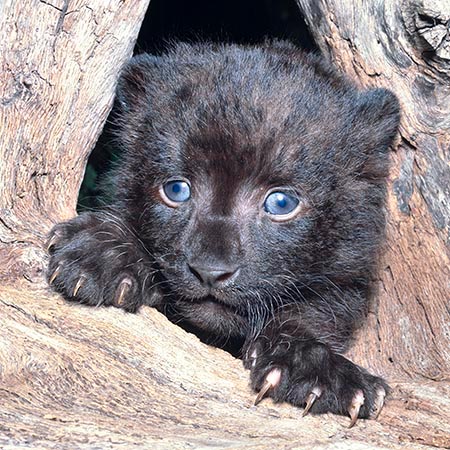
Young melanistic specimen of Panthera pardus © Giuseppe Mazza
Other authors add further subspecies such as the Panthera pardus pardus (African leopard), the Panthera pardus shortridgei (Central Africa leopard), the Panthera pardus suahelica (Eastern Africa leopard), the Panthera pardus melanotica (Cape leopard), the Panthera pardus ituriensis (Congo leopard), the Panthera pardus nanopardus (Somali leopard), the Panthera pardus antinorii (Eritrean leopard), the Panthera pardus reichinowi (Western Africa leopard), the Panthera pardus chui (Uganda leopard), the Panthera pardus adersi (Zanzibar leopard) and the Panthera pardus leopardus (Western Africa forests).
It is thought that the Indian leopard ( Panthera pardus fusca ) can be in its turn subdivided into two more subspecies: the Kashmir leopard ( Panthera pardus millardi ) and the Nepal leopard (Panthera pardus pernigra).
And till 30 years ago, some biologists were considering divisible in ulterior subspecies the Persian leopard (Panthera pardus saxicolor) and were talking of the Panthera pardus tulliana (Anatolian leopard), the Panthera pardus ciscaucasica (Caucasus leopard), the Panthera pardus sindica (Baluchistan leopard), the Panthera pardus dathei (Central Persia leopard) and the Panthera pardus jarvisi (Sinai leopard).
Finally, there are also inter-specific hybrids, leopard-lion or leopard-puma (pumapard), obtained in captivity in the context of zoological gardens. The differences, which concern the dimensions, the composition and the colour of the mantle, are often not much evident and the debate is still open.
The international organization in charge of the zoological taxonomy (ICZN) seems to tend to the classification in the nine aforementioned main subspecies.
We say at once that the discourse about the melanism of the leopard, caused by a mutation at the expenses of a recessive gene, has been amply developed in the text of the Panthera onca, reminding that the frequency of melanism is greater in the jaguars (mutation of a dominant gene), than in the leopards, and that it usually concerns specimens endemic to forest biotopes.
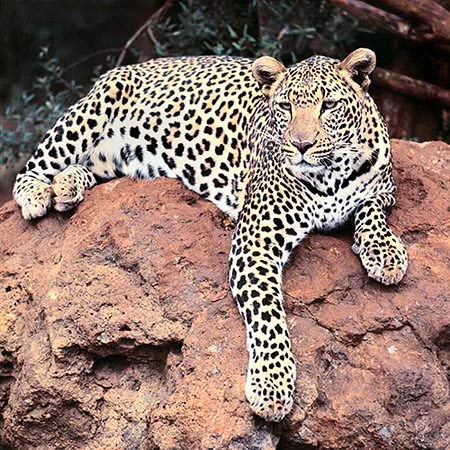
In Africa, Panthera pardus is called leopard, in Asia, panther © Giuseppe Mazza
We must add that the leopard has a density of population more important in Africa than in Asia, where the intensive deforestation renders its permanence every day more difficult. The relationship man-leopard has then a deep connexion.
Since the last century, in fact, leopards were trained for hunting big animals, such as the Cape buffalo (Syncerus caffer), the Hippopotamus (Hippopotamus amphibius) or even the Elephants (Loxodonta africana and Elephas maximus ), not because they can kill them, but for rousing them, thanks to their incredible sense of smell, hearing and their perfect nocturnal vision.
As a matter of fact, both in Africa and in Asia, they have registered attempts of attack by a Panthera pardus to hippopotamuses, Cape buffaloes and elephants, caused by such a marked and prolonged alimentary scarcity to induce them to run the risk. Furthermore, ethnologically, some African tribes, particularly in Congo, Kenya and Tanzania, worship this animal so much to assume it as a symbol. So, they talk about “human leopards”, real sects of warriors, like the “lion men”, the “baboon men” and the “hippopotamus men”. Less lucky than the jaguar, the leopard has a wide choice of foes in his habitat. Big animals like hippopotami, elephants, buffaloes or rhinos, if rashly attacked, and predators, such as lions, hyenas, African wild dogs, crocodiles and tigers.
Zoogeography
Leopards are endemic to sub-Saharan Africa, with greatest density in the equatorial belt, and to continental Asia, Java and Sunda Islands included, but, sporadically, they can be found also in the Sahara desert, in the highlands of Moroccan Atlas and in desert areas of Tunisia and Algeria. They have been sighted also in Asia Minor, Turkey, Korea and Manchuria. The black panther has its greatest density in the tropical forests of Java.
Habitat-Ecology
These animals have such a plastic physiology and alimentary ecology that they can live in almost all possible biotope and eco-systemic combinations. They can be met in the evergreen rainy tropical forests, in desert areas, in stony and rocky regions, in swampy and reedy areas, along water streams, in snowy locations, plains and savannahs up to even several thousands of metres above the sea level. They are found in the bush and usually in the woody African and Asian zones.
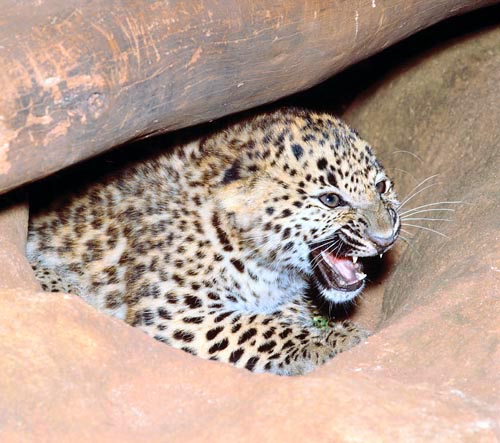
Cub of leopard by its den entrance © Giuseppe Mazza
Like jaguar, the leopard spends most of its day on a tree, resting while lying on the branches, and where it carries the remains of its preys, for eating them calmly when hungry. It hunts preferably on the ground, antelopes, gazelles, impalas, and other small herbivores, but when alimentary constraints arise, it can look on the trees for small preys such as squirrels and birds, but also big monkeys, such as the jockos (Pan troglodytes), and can prey along water streams, gavials, fish, amphibians and water birds.
Leopards are good swimmers, but they love water considerably less than the jaguar and the tiger. Unlike these ones, in fact, leopards never run after their preys when these try to escape by jumping in a water stream.
A curiosity. The leopard is one of the few carnivores of the African savannahs daring to attack and kill a Porcupine (Hystrix cristata). Even lions prefer to avoid this animal due to its enormous aculei. And they are not wrong, as the poor leopard, after the meal, is often covered by aculei. Some of them fall down, but others can creep into the soft tissues of the animal while it is moving. They can penetrate even 3 cm by day, and when they reach a vital organ, heart or liver, the leopard is done for. So, in a certain way, the porcupine takes its vengeance.
Morpho-physiology
The height at the withers is of about 70 cm. The male can reach a length of 190 cm and the female 140 cm, tails, which may easily be 70 cm long, included. The tails are useful for keeping the balance on the branches of the trees. A male has an average weight of 60-70 kg, a female 40-50. When in the wild, they live on an average of 12 years, in captivity, where they reproduce very well, even 23.
During the first meal they eat about 5 kg of the prey they have killed. Then, they carry the carcass on a tree in order to hamper lions, African wild dogs, tigers and hyenas to steal it. They eat it even when the meat is putrefying and do not disdain even the wastes left by other predators. They are really true sweepers.
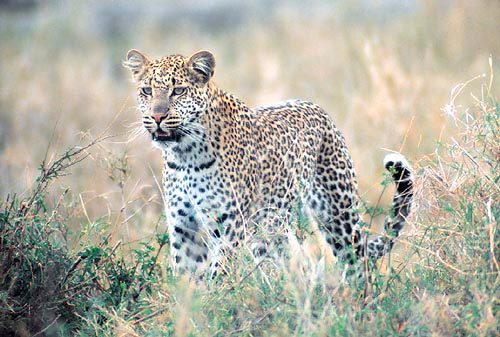
The leopard has a great alimentary adaptability © Giuseppe Mazza
The mantle is yellowish, with several black spots, rounded and full. They are digitigrades; they have retractile claws and walk silently on the pads, thus surprising their preys. Like all felines, they have an excellent sense of smell, eyesight adapted to the darkness and a very sharp hearing. Leopards are however very strong, even if less robust than a jaguar or a lion. Just think that with their powerful mandible they are able to carry on the trees, up to several metres of height, preys much heavier then themselves, like, for in stance, and antelope.
Antelopes and gazelles are their main course. They run after them, or jump on them from the trees on the loins, for then suffocating them with a bite on the throat. They eat at once the liver, heart and the thighs, putting aside what remains.
They prefer hunting by night, but it is not rare to see them preying also during the day.
Ethology-Reproductive Biology
The leopards are solitary animals, like the tiger and the jaguar. They live in home-ranges with dimensions varying from 5 to 25 square km, with the limits marked by repeated urinations and typical scratches on the trunks of the trees. They can roar, but their sound is less strong than the lion’s one. Therefore, contrary to the king of the savannah, they do not utilize vocal signals for marking their territory.
If a male passes quickly in the territory of another leopard, it is not attacked, but if the stay gets longer, then the fight is unavoidable. Usually, the males get close to the females in oestrum immediately. They smell the vagina and the anus, they taste the urines for feeling the receptivity and establishing their health status and then the mating takes place. This, as it happens for the lion, the jaguar and the tiger, is formed by short sequential intercourses. After the mating, the male remains a few days with the female and then gets away. The female delivers and breeds the cubs alone. It has an endotheliochorial placentation with zonary structure, has polyparous deliveries, generating one to six cubs.
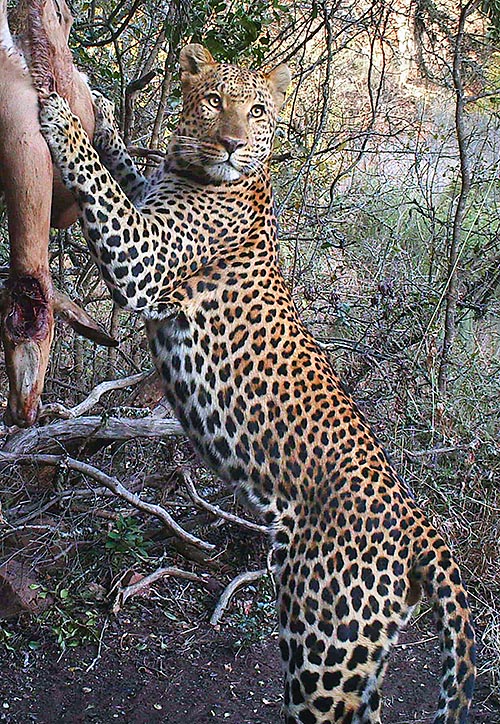
Leopards often carry the killed preys to a safe place on a tree © Gianni Olivo
The underweight newborns which do not weigh more than 500 gm at their birth, are abandoned to die by the mother. It does not give milk to them, applying a sort of eugenic selection, thing which is extremely sad! Usually, only 1-2 cubs do survive at each delivery. The female watches over them with love, nursing them for about three months. When it gets away looking for food, for eating it and producing the milk, it leaves them hidden in a den.
The weaning begins by the third month. Even if they are already able to walk a few days after their birth, it is only by then that the mother takes them while hunting. They must observe and learn quickly as to how find the food and to defend. When eight months old, they are already able do kill small herbivores, squirrels, small antelopes and reptilians. When in presence of a herd of hyenas or African wild dogs, a mother with two cubs, however strong and striving can it be, will be able almost always to save only one cub, carrying it away by the scruff.
The cubs live with the mother for about a year and a half, then they start their independent life. The mother, entering the oestrum, is again ready for coupling, whilst during the breeding of the progeny it is refractory on the reproductive point of view. With such a differentiated diet, preferably antelopes and gazelles, but also monkeys, fish, reptilians, amphibians and birds, the leopards are classified as euryphagous.
This great alimentary adaptability, compared to that of other felines and animals, has rendered them more resistant to the decrease of the population and therefore to the risk of extinction. But in some areas, especially the Asiatic ones, the leopard has reckon with the deforestation which reduces at the same time its home-ranges, not to talk about the number of the preys (herbivores, ungulates, reptilians, amphibians) in continuous decrease. The stress is so much that both the melanistic specimens and the wild-type, such as the subspecies endemic to those biotopes, are reported in the Red List of Endangered Species of the IUCN.
